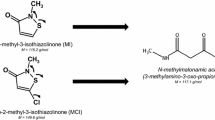Summary
Following oral administration of 14C labelled 8-methoxypsoralen (8-MOP) in man the plasma level course, the metabolite-patterns and the elimination of the parent compound and its metabolites have been investigated. Additionally the results discovered have been compared with the data of pharmacokinetics on dog and rat. In man and rat the plasma protein binding of 8-MOP has been determined.
Maximal levels of the total radioactivity in the plasma were achieved 2 h after dosing. At this time 8-MOP represents 50% of the radioactivity in the plasma.
The plasma protein binding in vitro of 14C 8-MOP valued from 88% to 91% in man, and between 75% and 83% in the rat.
Urinary elimination of the total radioactivity as a measure of the extent of absorption varies greatly and depends on the therapeutic formulation being employed. Following the administration of the solution 74% is recovered within 48 h. Faecal elimination of the total radioactivity reached 14% within 3 days.
The metabolite-pattern does not show the unchanged 14C 8-MOP. Several polar metabolites occur in the urine among which biochemical conjugates have been recognized. Only polar metabolites are observable in the faeces from which the radioactivity is incompletely extractable. From a comparison of the metabolite profiles, the rat as well as the dog seem to be a useful animal species for experimental investigations with 8-MOP.
Zusammenfassung
Nach oraler Gabe von 14C-markiertem 8-Methoxypsoralen (8-MOP) an den Menschen wurden Plasmaspiegel, Metabolitenmuster und die Ausscheidung der Muttersubstanz und ihrer Metaboliten untersucht. Die gewonnenen Ergebnisse wurden jeweils mit den erstellten pharmakokinetischen Daten von Hund und Ratte verglichen. Außerdem wurde die Plasmaproteinbindung von 8-MOP beim Menschen und bei der Ratte bestimmt.
Das Plasmaspiegelmaximum der Gesamtradioaktivität wurde 2 h p.a. erreicht. Zu diesem Zeitpunkt liegen 50% der Radioaktivität als Muttersubstanz vor.
Die Plasmaproteinbindung in vitro von 14C 8-MOP liegt beim Menschen bei 88–91% und bei der Ratte zwischen 75% und 83%.
Die renale Eliminierung der Gesamtradioaktivität, die ein Gradmesser für die Vollständigkeit der Resorption ist, kann stark variieren und hängt von der verwendeten Formulierung ab. Nach Gabe von 14C 8-MOP in Lösung werden 74% über den Urin innerhalb von 48 h ausgeschieden. Die Elimination über den Stuhl betrug 14% innerhalb von 72 h.
Das Metabolitenmuster zeigt kein 14C 8-MOP im Urin. Aber es zeigt polare Metaboliten, die teilweise aus Konjugaten bestehen. Aus den Faeces des Menschen ist die Extraktion der Radioaktivität unvollständig. Hier werden aber nur polare Metaboliten nachgewiesen.
Da Hund und Ratte qualitativ vergleichbare Metaboliten wie der Mensch aufweisen, können Ergebnisse, die an diesen beiden Spezies gewonnen werden, als relevant für den Menschen angesehen werden.
Similar content being viewed by others
References
Mortazawi, S. M. A.: Meladinine und UVA bei Vitiligo, Psoriasis, Parapsoriasis und Akne vulgaris. Derm. Mschr. 158, 908–909 (1972)
Parrish, J. A., Fitzpatrick, T. B., Tannenbaum, C., Pathak, M. A.: Photochemotherapy of psoriasis with oral methoxsalen and longwave ultraviolet light. New Engl. J. Med. 291, 1207–1211 (1974)
Lerner, A. B., Denton, C. R., Fitzpatrick, T. B.: Clinical and experimental studies with 8-methoxypsoralen in vitiligo. J. Invest. Dermathol. 20, 299 (1953)
Pathak, M. A., Mandula, B., Nakayama, Y., Parrish, J. A., Fitzpatrick, T. B.: Cutaneous photosensitization and in vivo metabolism of psoralens. J. Invest. Dermathol. 64, 279 (1975)
Jacobsen, T., Øystein, M.: Analysis of 8-methoxypsoralen by HPLC. J. Pharm. Sci., in press, personal communication
Gazith, J., Schaefer, H.: 8-methoxypsoralen: Its isolation and gaschromatographic determination in aqueous solution and serum. Biochem. Med. 18, 102–109 (1977)
Pathak, M. A.: Lecture presented at VIIth Int. Congress on photobiology, Rome 1976
Busch, U.: Unpublished results
Author information
Authors and Affiliations
Rights and permissions
About this article
Cite this article
Busch, U., Schmid, J., Koss, F.W. et al. Pharmacokinetics and metabolite-pattern of 8-methoxypsoralen in man following oral administration as compared to the pharmacokinetics in rat and dog. Arch Dermatol Res 262, 255–265 (1978). https://doi.org/10.1007/BF00447362
Received:
Issue Date:
DOI: https://doi.org/10.1007/BF00447362




